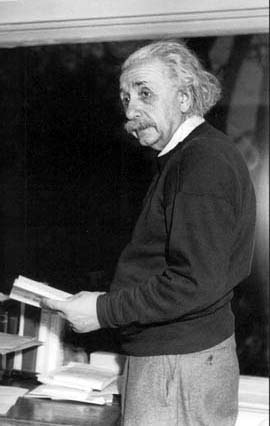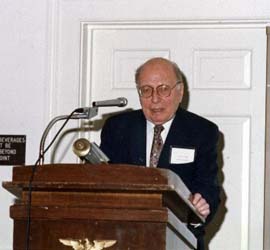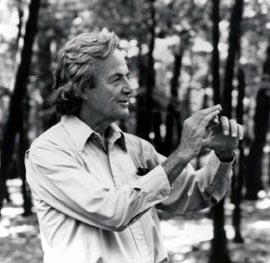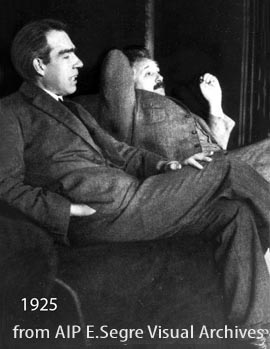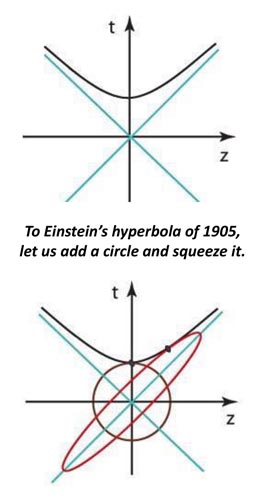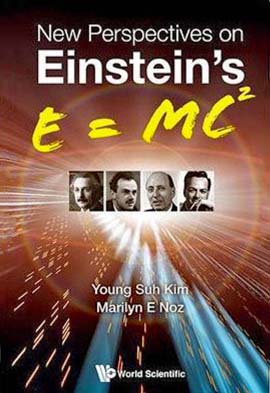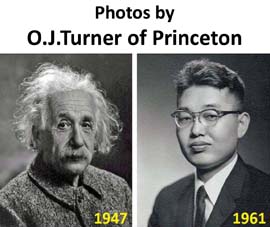Sagamore Beach MA: Science History Publications,/USA 2006, ISBN: 0-88135-283-7.
published in shortened form in Brit. J. Hist.Sci. 41.i (no.148) 148-149, March 2008
Each of Albert Einstein’s three ground-breaking papers of 1905 is nowadays
considered to have merited the Nobel physics prize. He was nominated from
1910 onwards by increasing numbers of leading physicists. Only in 1922 was
he awarded the deferred 1921 prize and on very narrow grounds, namely for
the law of the photoelectric effect.
How did this happen? Elzinga's book
based on the Nobel archives illuminates the tortuous path taken – from a
narrow interpretation of Alfred Nobel's terms to antagonism on the
four-man physics committee and a fudged compromise when the international
credibility of the prize was at stake. As ‘Nobel laureate’ status is for
many scientists the highest aspiration, the awarding system is significant
in direction-setting and its functioning has high importance.
The awards influenced the key developments of 20th century science, for
good or ill. Einstein could have been awarded the prize for his
contribution on Brownian motion, revealing the molecular structure of matter
and forming the basis for statistical physics. His award could have been
for contributing to quantum physics, the overarching theory of the subsequent
century. Or the award could have been for the special and general theories
of relativity. But it was specified just for an experimental 'law' relating
the frequency of ultra-violet light to the energies of the electrons it
ejects from metals. The novelty lay in light interacting with solids on
the atomic scale and in Planck's quantum constant 'h' featuring in the law.
Elzinga makes clear the Nobel committee would not reward creative science,
but only 'discovery or invention'. It definitely did not reward 'metaphysics
and speculation', a stance relaxed in recent decades. Though Einstein's
novel concept of duality (spelled out in 1909) went unmentioned in the
citation, his prize is frequently attributed to his role in originating
quantum theory. The 1982 biographer, Abraham Pais (Subtle is the Lord…
The science and life of Albert Einstein, Oxford 1982) stated, indeed,
that the award was rightly given for quantum physics (despite most
nominators arguing for relativity) and lauded the "judgement of a
highly responsible rather conservative body of great prestige… (the)
story has neither heroes nor culprits" (p503).
Elzinga’s judgement is different and his analysis pulls no punches,
showing a verdict cobbled together amidst personal biases, for a
narrow experimental law. Chance had intervened with the unexpected
death of the committee chairman. The hero was a new committee member
(C W Oseen) who saw the others were set against relativity, so argued
for the 'law' being fundamental and underpinning Bohr’s atom model.
He successfully argued for a package using the deferred 1921 prize – one
to Einstein and the second to Niels Bohr. But such was the animus
against relativity theory that at the Swedish Academy’s plenary
meeting, the astonishing reservation was added to Einstein’s certificate:
"independent of the value that (after eventual confirmation) may be
credited to the relativity and gravitation theory".
This reflects the refusal throughout the decade to award a prize for
relativity, revealing inadequacies and prejudices of committee members
that Elzinga exposes in detail.
The records for 1910 and 1912 show they should have awarded the prize for
special relativity of the 1905 paper, which synthesised 19th century
electromagnetism and the finite speed of light, while predicting
increasing mass of an electron at relativistic speeds. By 1914-15
experimental tests confirming this fundamental ‘law’ would normally
have satisfied the physics committee. But from 1914 they shifted the
grounds of argument to the new general relativity theory (not published
in full till 1916). Through 1917-19, they said the bending of light rays
by the sun was controversial and emphasised that no gravitational red-shift
had been detected in the sun’s light. These were seen to outweigh the
success of the third test (advance of the perihelion of the planet Mercury).
It is easy now to see that the conflation of 'special' and 'general'
relativity by Einstein's peers was a mistake. Nearly all the nominations
mentioned the two together, so the Committee was able to sidestep
considering special relativity on its own (argued by von Laue) and
insist that relativity fell short over the gravitational red-shift,
even though detecting this was far beyond instrumental capability
for that time. But the mistake arose also via nomenclature, as the
'general' theory is really a theory of gravitation and largely distinct.
The special theory is of highest importance for fundamental notions of
simultaneity and (equivalent) inertial frames and for its prediction of
gravitational waves, whereas the general theory is still disputed, its
formulation giving difficulty with gravitational waves etc**. The
notion of ‘locality’ is another basic concept emerging from the special
theory, on which Einstein insisted in his 1930s argument with quantum
theorists and which remains a touchstone today.
The Nobel committee needed by 1921 to find a way out over Einstein,
because of his high public profile as well as international
scientific prestige. But a second reason for their change in view
was a wish to play conciliator over the post-1918 ‘cold war in science’.
The Swedish chemist, Svante Arrhenius and physicist Carl Wilhelm Oseen
with others in neutral Sweden valued scientific internationalism and
wanted to bring together scientists from the former warring countries.
Elzinga says the prize committees sought to use the awards as a political
instrument (as the Peace prize is used today). They made awards to
several German scientists - Planck, Stark, Haber (despite involvement
in gas warfare) and von Laue – and arranged a special celebration for
the wartime nobelists in June 1920. Only Charles Barkla attended from
the English-speaking world (not the Braggs) and praised the
“truly international” award. Despite controversy (over Haber), its
long-term prestige did apparently benefit. The 1921-2 awards to
Einstein and Bohr were needed to restore credibility. Einstein’s 1923
acceptance lecture was on relativity (then seen to be his major work)
at the instigation of Svante Arrhenius, who thus had reversed his
opposition in committee.
Elzinga fails to say directly that Abraham Pais was mistaken,
despite their quite different assessments of the Nobel committee’s
decision-making. He does not explain how Pais’s short chapter based
on the same Nobel archive could be so wrong.
Pais’s would have spent limited time on the archive, in writing his
short chapter. But he should have identified important issues and
uncertainties for others to explore. It could be that Pais had no
Swedish language facility, causing him to overlook the contorted
arguments that Elzinga details from the lengthy internal reports. As
Pais knew the nominations were predominantly for relativity, one infers
that he was guessing when he excused the committee as lacking expertise
in relativity** and wanting experimental issues clarified. This lame
excuse overlooks the clear prejudice of committee members against
relativity that Elzinga describes.
Pais concluded (Elzinga p. 4) that the prize was for applying quantum
theory and rightly (he says) given for “the most revolutionary
contribution (Einstein) ever made to physics”. This appears to be a
pre-formed conclusion, reflecting Pais’s orientation in quantum physics.
It’s an important issue for a modern biographer, because Pais’s 1982
biography carries authority and prestige for its exposition of
Einstein’s science. It was reissued in 2005 with endorsements by
prominent physicists. However
- it’s a partisan assessment that chimes with the heyday of quantum
physics in the 1970s and early 80s
- it established the myth the Einstein lost the great Bohr-Einstein
debate of the 1930s
- it has failed to stand the test of time, in that Einstein
persisted with criticisms of quantum theory till he died, while
the issue did not die with him. Quantum scepticism has increasingly
surfaced in the first years of the new century
- in particular, Pais did not address the concept of locality that
is fundamental to Einstein’s view of reality
- citation statistics show the EPR paper of 1935 to be a “revived
classic” with few citations till ~1990 and a large upsurge since
then. It is the only paper by Einstein in Physical Review that has
this classic status (Citation Statistics from 110 Years of Physical
Review, S. Redner, Physics Today 58, 49 (2005)).
Elzinga’s study is an excellent eye-opener. Yet he was reluctant to
challenge the authority of Pais, though biographies are naturally written
within a social and cultural context. Not to bring out further where
Pais’s authoritative biography went wrong is an unfortunate deficiency.
Nevertheless, Elzinger helps us recover Einstein's story from the
tendentious interpretation of it that has gone unchallenged for too long.
Elzinga’s absorbing story opens an important avenue for further research
and wide debate: was and are the Nobel science awards right to stress
experiments and discovery over theorising? This implies not explicitly
rewarding creative science. Though in practice ways to do this can be
found – the criteria are “rubbery” says Elzinga – there remains a strong
bias to waiting for experimental verification. Thus there has been no
Nobel prize for the prediction of black holes. Voices are increasingly
saying that 20th century physics became super-theoretical (Lee Smolin,
The Trouble with Physics, Houghton-Mifflin, Sept. 2006 / Penguin (UK),
Feb. 2007). Certainly, multi-dimensional cosmologies, retro-causality
and instantaneous collapse of astronomical scale wave-functions are
speculative and so remote from experiment as to be unqualified for Nobel
awards. On this argument the Nobel Committee is one institution that
helps keeps science sane.
MAX K WALLIS, Cardiff University
TREVOR W MARSHALL, Manchester University
NOTE.
** Indeed Allvar Gullstrand did have published work on general
relativity (1922) and his name is still attached to Painlevé-Gullstrand
coordinates. His 1921 report opposing the award of the prize did
criticise the absence of dynamic solutions (gravitational waves)
which is a longstanding issue (Lo, 2006) and relates to the “ambiguity”
(non-unique) objection to GR published by Whitehead (1922) which is
central in the Relativistic Theory of Gravitation (Logunov 2001, 2006).
Thus Gullstrand’s scepticism over the three tests was underpinned by
basic theoretical questioning. Perhaps this (healthy) scepticism was
also shared by wider sections in the full Swedish Academy.
- Whitehead, A.N.: The principle of relativity. Cambridge University
Press, Cambridge (1922)
- Gullstrand, A.: “Allgemeine Lösung des statischen Einkörperproblems
in der Einsteinschen Gravitationstheorie” Ark. Mat. Astr. Fys. 16(8)
1–15 (1922)
- Lo, C. Y.: The Gravitational “Plane Waves” of Liu & Zhou and the
Nonexistence of Dynamic Solutions for Einstein’s Equation, Astrophys
Space Sci (2006) 306:205–215
- Logunov, A. A. : The Theory of Gravity, Nauka, Moscow (2001)
- Logunov, A. A. : Relativistskaya Teoria Gravitatsii, Nauka, Moscow (2006)
